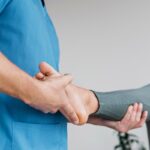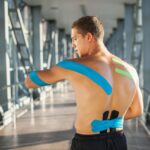Joint Back Pain Relief
Back pain is one of the most common ailments affecting people worldwide, often caused by muscular strain or overexertion. However, joint-related issues are frequently overlooked as contributors to back pain. Joint back pain can arise from a variety of underlying causes, many of which are not solely related to muscle strain.
At Rapid Relief Medical Group, we understand the complexities of back pain and its causes. In this blog, we will explore the common causes of joint back pain beyond just muscular issues and provide insight into how these conditions can impact your daily life. For more detailed information on diagnosis, treatment, and steps you can take to manage back pain, visit NIAMS: Back Pain – Diagnosis, Treatment, and Steps to Take.
Understanding Joint Back Pain
Joint pain occurs when the structures of the spine, including the vertebrae, discs, and the surrounding joints, become damaged or inflamed. While muscle strain is a common cause of back pain, joint issues can also contribute significantly to discomfort. Understanding the role of joints in the spine and how they can become a source of pain is key to managing and treating back pain effectively.
The spine consists of three main parts: the cervical (neck), thoracic (mid-back), and lumbar (lower back) regions. These regions are connected by a network of joints that allow for flexibility and movement. When these joints become inflamed or damaged, it can lead to back pain that may be mistaken for muscular discomfort.
Common Causes of Joint Back Pain
Several conditions can lead to joint-related back pain. These conditions are often degenerative and may occur as a result of aging or injury. Here are some of the most common causes:
1. Osteoarthritis (Degenerative Joint Disease)
Osteoarthritis is one of the most common causes of joint pain, especially in the spine. This degenerative condition occurs when the cartilage that cushions the joints breaks down, leading to pain, swelling, and stiffness. In the spine, osteoarthritis can affect the facet joints, which are the small joints located between each vertebra. As the cartilage deteriorates, bone spurs may develop, which can impinge on the spinal nerves, causing pain in the back.
Symptoms of Osteoarthritis:
-
Stiffness and reduced flexibility
-
Chronic back pain that worsens with movement
-
Swelling in the affected area
-
Pain radiating down the legs (if nerve involvement occurs)
2. Spinal Stenosis
Spinal stenosis occurs when the spaces within the spine narrow, putting pressure on the spinal cord and nerves. This narrowing can occur in the lumbar (lower back) region, leading to pain in the lower back, hips, and legs. Spinal stenosis is most often caused by degenerative changes, such as osteoarthritis or the thickening of ligaments, which can compress the spinal nerves and lead to joint back pain.
Symptoms of Spinal Stenosis:
-
Back pain that increases with standing or walking
-
Numbness or weakness in the legs
-
Difficulty walking or maintaining balance
-
Shooting pain down the legs (sciatica)
3. Sacroiliac Joint Dysfunction
The sacroiliac joints are located at the base of the spine, where the sacrum (the triangular bone at the bottom of the spine) meets the iliac bones of the pelvis. Dysfunction in the sacroiliac joints can result in lower back pain, especially when there is inflammation or misalignment. This condition is commonly associated with pregnancy, injury, or repetitive stress on the lower back. When these joints are inflamed, it can lead to significant discomfort and difficulty in mobility.
Symptoms of Sacroiliac Joint Dysfunction:
-
Sharp or aching pain in the lower back or buttocks
-
Pain that worsens with sitting or standing for long periods
-
Difficulty bending or twisting the body
-
Pain radiating down the hips or thighs
4. Spinal Injuries or Fractures
Injuries to the spine, including fractures or trauma to the vertebrae, can result in joint pain in the back. Fractures often occur due to accidents, falls, or high-impact trauma. The damage to the vertebrae can disrupt the normal function of the joints, leading to pain and discomfort. Fractures or injuries can also increase the risk of developing conditions like osteoarthritis or spinal stenosis over time.
Symptoms of Spinal Injuries:
-
Sudden, severe pain in the back
-
Swelling or bruising in the affected area
-
Limited range of motion
-
Numbness or tingling in the extremities
5. Spondylolisthesis
Spondylolisthesis occurs when one vertebra slips out of place over the vertebra below it. This condition can lead to instability in the spine and result in joint back pain. Spondylolisthesis may be caused by congenital defects, degenerative changes in the spine, or trauma. The misalignment of the vertebrae can place pressure on the spinal nerves, resulting in pain, stiffness, and potential nerve damage.
Symptoms of Spondylolisthesis:
-
Lower back pain that radiates into the buttocks or thighs
-
Muscle spasms in the lower back
-
Difficulty standing or walking for extended periods
-
Numbness or weakness in the legs
How Joint Back Pain is Diagnosed
At Rapid Relief Medical Group, diagnosing joint back pain involves a comprehensive evaluation by our specialists. This may include:
-
Physical Examination: A thorough assessment of your spine, posture, range of motion, and muscle strength.
-
Imaging Tests: X-rays, MRIs, or CT scans to evaluate the condition of your joints and surrounding structures.
-
Patient History: Understanding the nature of your pain, any prior injuries, and lifestyle factors that may contribute to your symptoms.
Based on these diagnostic tools, a customized treatment plan can be created to address the root cause of your joint back pain.
Treatment Options for Joint Back Pain
Treatment for joint back pain depends on the underlying cause and severity of the condition. Common treatment options include:
-
Physical Therapy: Focuses on strengthening the muscles around the spine to provide better support for the joints and alleviate pain.
-
Medications: Nonsteroidal anti-inflammatory drugs (NSAIDs) can reduce inflammation and relieve pain, while corticosteroid injections may be used for more severe inflammation.
-
Surgery: In rare cases, surgery may be necessary to address issues such as spinal stenosis or fractures.
At Rapid Relief Medical Group, our team of experienced professionals is dedicated to helping you manage your back pain and regain your quality of life through a variety of non-invasive treatment options.
Conclusion
Joint back pain is a complex condition that can arise from a variety of causes beyond just muscular strain. Conditions such as osteoarthritis, spinal stenosis, and sacroiliac joint dysfunction can all contribute to chronic back pain. By understanding these conditions and seeking the right treatment, you can alleviate your symptoms and improve your overall well-being.
If you are experiencing joint back pain, don’t wait to seek help. At Rapid Relief Medical Group, we specialize in personalized care and treatment plans to address the unique needs of each patient. Contact us today at 908-941-4762 or visit our website at https://rapidreliefpt.com/ for more information on how we can help you find relief.













